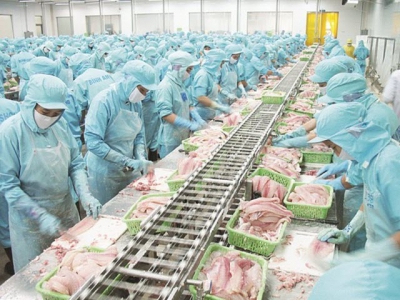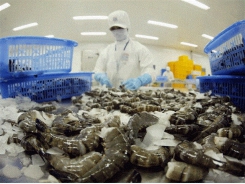Pangasius export: To be stable, it must be exported in official method

In recent years, exporting pangasius into the Trung Quoc market has had strong growth, which is considered a "rescue" for the whole sector. However, stringent market requirements are demanding the pangasius sector change to really focus on quality as well as boosting export in the official method in order to develop sustainably.
China is the leading pangasius export market of Vietnam with about 25% of market shares. Picture: Nguyen Thanh.
Strong growth
According to the Vietnam Association of Seafood Exporters and Producers (VASEP): In the last 5 years, the Vietnamese proportion of pangasius exports into China has grown at an average rate of 21% - 31% each year. In the first seven months of this year, exports of pangasius reached US$ 1.2 billion, up 19% over the same period last year. In particular, China is still the leading export market.
Referring to the role of the Chinese market for pangasius exports, Mr. Duong Nghia Quoc, Chairman of the Vietnam Pangasius Association, said that China has been a key export market of Vietnam in recent years. For example, in 2017, the pangasius sector faced many difficulties, from anti-dumping tariffs to smear media in some EU countries, and the Farm Bill Act of the United States… While pangasius export turnover in key markets declined strongly, such as to the United States, the export increase to the Chinese market with over 40% is considered as an important “rescue”. In the first half of this year, China is still the leading pangasius import market for Vietnam with about 25% of market share, higher than the figure of 18-20% of the US market.
In fact, since July 1, the import tax on pangasius in China has been adjusted down about 3 to 4%. Specifically, fillet tariffs of frozen pangasius dropped from 10% to 7%; Tariffs on fresh or chilled pangasius fish have dropped from 12% to 7%. This is seen as a favorable factor creating more opportunities for the enterprises to promote pangasius export into China. According to the latest information from MARD, at present, the Chinese importers have stopped temporarily buying the Vietnamese pangasius to consume all goods imported. As a result, many enterprises have reduced the purchase of material pangasius from the farming households despite the weather being favorable to breed young fishes. However, pangasius price forecasts are still favourable for farmers’ profits from now until the end of the year.
Assessing on the long-term potential of the Chinese market for pangasius, Mr. Truong Dinh Hoe, General Secretary of VASEP analyzed, China was not only a large market but also a country with diverse cuisine. Meanwhile, pangasius is a suitable product for cooking hundreds of different dishes. The domestic pangasius sector could increase the export of value added products into this market.
Promote export in the official method
Although Mr. Hoe highly appreciated the potential of pangasius export into the Chinese market, he also emphasized, “This is a unstable market. The pangasius export into China market is growing continuously, but in fact, some enterprises purchase in the old ways of thinking, which is to sell products produced by themselves without examining the market demand to both control the price and ensure enough for consumption.”
According to VASEP, many regulations of the Chinese State make the Vietnamese seafood exporters confused. Typically, the regulation of the phosphate residue in pangasius, under the European regulation on the non-chemical goods, the phosphate residue does not exceed 4%. However, when inspecting the Vietnamese pangasius products, the Chinese partner only assessed these products had residue, and did not meet the standards of China. Particularly, when the pangasius exports into the Chinese market increased sharply, China began to squeeze the safety issues for the goods. China does not control the quality of border crossing imports. Therefore, such control is considered unfair for the official imported products. Meanwhile, goods exported through the borderline do not have to bear the 17% Value Added Tax, so price competitiveness is very good compared to official imported products.
Around the difficult story of pangasius export, Mr. Nghia added, in the first half of this year, according to information from the management agencies as well as the enterprises, in the total export turnover of pangasius into China, export through sub-border gates was about 40%. A price difference between export through the major-border gates and export through sub-border gates was about US$ 1/kg. The export through sub-border gates was quite complex, unstable and risky. Worst of all was the quality. After the export, the importers could process further, affecting the reputation of Vietnam pangasius. "In order to stabilize long-term business, the State, the trade associations and industries should work with the Chinese authorities to export through the official channels. Especially, with all kinds of export, the first thing for the enterprises is to ensure quality. In addition, the enterprises need to link well with the reputable distributors in China, and provide the appropriate payment methods to limit risks,” he emphasized.
In order to promote the fishery export in general, especially pangasius in particular into the Chinese market, the VASEP also said that one of the important solutions was to focus on quality control, boosting export in the official methods, control exports through the sub-border gates. China is no longer a low-end market, but has been a growing market and sensitive for food safety and hygiene issues, so the Chinese consumers were looking for the imported products accepted in European and American markets, including Vietnamese pangasius.
The VASEP recommended that the MARD should have a program to inspect the processing units of fishery products to ensure the quality of seafood exported across borders. In addition, to promote the seafood export into the Chinese market in the future, the promotion of Vietnamese seafood into China should be promoted more. The VASEP also requested the Government should have long-term support policies to promote export into the Chinese market, at the same time, the MARD should research the Chinese market development strategy, have marketing and communication programs to promote the seafood products into this large market.
Có thể bạn quan tâm
Phần mềm

Phối trộn thức ăn chăn nuôi

Pha dung dịch thủy canh

Định mức cho tôm ăn

Phối trộn phân bón NPK

Xác định tỷ lệ tôm sống

Chuyển đổi đơn vị phân bón

Xác định công suất sục khí

Chuyển đổi đơn vị tôm

Tính diện tích nhà kính

Tính thể tích ao hồ




 Reader beware of predatory scientific aquaculture literature
Reader beware of predatory scientific aquaculture literature  Conference discusses global shrimp demand, Vietnam’s supply capacity
Conference discusses global shrimp demand, Vietnam’s supply capacity